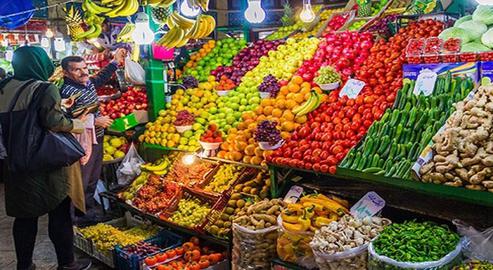On Tuesday, November 30, Mostafa Daraeinejad, president of the Tehran Bar Association, told Iranian media that oranges, kiwis, pomegranates, apples and tangerines were rotting on market stalls because no-one could afford them. He reported a 50 percent reduction in fruit consumption in Iran, attributing this to a decline in people's purchasing power.
Fruit sellers in and shoppers in Tehran spoke to IranWire’s citizen journalist and confirmed the same.
***
Pomegranate is one of the biggest luxuries among autumn fruits this year. Its cost in fruit shops has now exceeded 30,000 tomans ($1). Last year, the 20,000-toman price tag made headlines, but was blamed then on “intermediaries” in the fruit market. No matter who’s setting the price, what is clear is that the cost of comestibles in Iran has hit all-time heights in 2021.
A fruit seller in the Sadeghieh neighborhood of Tehran, who introduces himself as Haji Arzani [Mr. Cut-Price] and whose shop sign bears the same name, says it’s got nothing to do with the merchants. “I swear to God, our profits haven’t gone up. Hand-picked, first-class fruit has been expensive every season, but I admit it is more expensive this year than ever. Thomson oranges, for example, cost 29,000 tomans per kilo and everyone says that’s expensive; no-one mentions that I paid 25,000 per kilo for it. I also have to cover my own needs and the shop overheads, and accept the risk of damage and losses.”
What of the cost of other fruits? Mr. Cut-Price declares: “A kilo of bananas is 33,000 tomans, tangerines 32,000 tomans, apples 27,000, tomatoes 17,500 and cucumber 14,000. The popularity of fruit, especially from fruit shops, has massively dropped. I agree that people can’t afford fruit at these prices; our business is getting more and more sluggish every day. No one knows who to blame." The only thing he can do, he says, is put the leftover fruit in a tray in front of the shop and sell it at a 50 percent discount the next day.
A male customer at a fruit shop in east Tehran confirms his family have changed their shopping habits; they now buy less, and go to wholesale markets to keep costs down. "We used to go to the grocers every time to buy things like tomatoes, potatoes and onions for cooking, and we always used to buy a few kilos of seasonal fruit too. For example, we’d buy apples and oranges in autumn and winter, and watermelons in summer. Seasonal fruit was always in our fridge. But now we can’t buy oranges; three or four weigh a kilo and cost more than 25,000 tomans. Now we only buy fruit when we have guests or on special occasions." He jokes: "According to today's youth, the fruit belongs to the luxury houses!"
Fruit and vegetable markets operate all over Tehran and are managed by the municipality. Everything has a set price there: bananas, for example, cannot be sold for more than 28,000 tomans per kilogram. If the cost in the wholesale market these stalls buy from goes beyond the approved rate, shopkeepers simply won’t buy it. For that reason in spring 2021, there were no bananas to be found at market stalls across the Iranian capital.
Soheila, who lives in the center of Tehran, says she now buys everything wholesale. “Naturally their fruit isn’t as good as the supermarket, but the quality’s not unacceptable, and a fairer price. For instance, when I went there yesterday, Thompson oranges cost 9,800 tomans per kilo and tangerines 13,200: totally different to the astronomical prices of supermarket fruits. Even pomegranate was 17,000 per kilo wholesale.”
"Even at the wholesale markets, though, the prices have gone up so much the amount we can buy is going down every day. Where I used to buy two to three kilos of oranges and tangerines a week, I now have to be content with just one and a half. It’s not just about us; it can cost 500,000 to 700,000 ($17 to $23) to do a weekly shop here now and for people on an average income of four million tomans ($136) a month it’s way too expensive. They have to make do and spend a few days at the end of the month with an empty fridge.”
Data on the cost of living from the Statistical Center of Iran cited by IMNA News Agency in May 2021 showed the average household in Tehran spent about 10 million tomans ($357) per month to meet its needs. The province with the lowest average monthly cost of living to families, about 5.6 million tomans ($190), was Sistan and Baluchistan, while the country-wide average was eight million tomans ($272).
Hassan is a driver on the taxi app SNAP. "Because of my job, I tend to go through different parts of the city," he said. “There are vans in the southern part of Tehran that often offer just one product, or two to three. In summer, for example, a van on the street corner sells watermelons; 200 meters away another sells cucumbers and tomatoes; another sells potatoes; and so on.” He prefers to make the journey to check out the vans, as their wares come directly from the producers and so are cheaper: “If I come across these vans during the day and the price is right, I’ll buy. If not, I won’t. It’s no longer the case that there should always be fruit in the house. A lot of the time, out refrigerator is empty.”
This article was written by a citizen journalist in Tehran under a pseudonym.
Related coverage:
Traders of Tehran Bazaar: 'Nobody's Buying!'
Letter from Tehran: Shoppers and Businesses Suffer from the Rising Price of Food
Citizen Journalist Report: Leaner Menus in Tehran for Rich and Poor
Why Inflation is Hitting the Poor in Iran Hardest
Tehran Supermarkets Shutting Down Over High Prices
Worsening Inflation Casts a Shadow Over Iranian New Year
Iranians Enter a New Century Poorer and Less Hopeful for the Future
Astronomical Prices of Fruit and Nuts Darken the Nowruz Mood
visit the accountability section
In this section of Iran Wire, you can contact the officials and launch your campaign for various problems

























comments